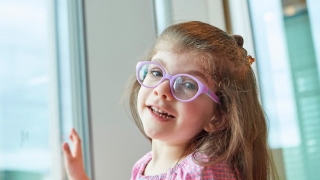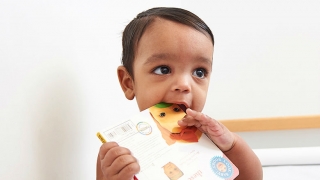Child Neurology Residency
About the Child Neurology Residency Program
In partnership with the Pediatrics Residency at CHOP, the Division of Neurology offers a five-year combined pediatrics and child neurology training program. Our mission is to train leaders in child neurology by providing:
- World-class training with unparalleled breadth and depth of knowledge in child neurology
- Tools and strategies for lifelong learning and critical appraisal of basic science, clinical research and health services research, and quality improvement practice
- Opportunities for career development through access to CHOP and Penn’s rich resources, career mentorship, and introduction to national and international neurology communities
We are a large division with more than 50 faculty members, with clinical and research expertise across the spectrum of child neurology. Clinical programs include epilepsy, stroke and neurocritical care, neuromuscular disorders, neuroinflammatory diseases, neurologic infections, neurogenetics, leukodystrophies, fetal and neonatal neurology, headache, community neurology, and global health. Our faculty practice at CHOP’s Philadelphia campus and at community sites around the region.
In addition to providing expert clinical care for children with neurologic disorders, our faculty and residents are engaged in basic and translational science research, clinical investigation and trials, patient safety and quality improvement, and health services research. A close relationship with colleagues across CHOP, Penn Medicine, the University of Pennsylvania, and the City of Philadelphia leads to unique opportunities for multidisciplinary collaboration. We are also engaged in a variety of national and international research efforts, including leadership in multicenter consortia.
We currently match seven residents per year into categorical (pediatrics + child neurology) positions. Our unique breadth of clinical and research opportunities allows us to support residents in their individual goals, connecting them with mentors and clinical experiences to prepare them for the career of their choice, ranging from community clinical practice to full-time research. Creating a diverse, inclusive, and caring environment where every trainee feels supported to be themselves is a core value of the program. Our mission includes fostering culturally competent child neurologists who listen and communicate well with every patient and family, ensuring that our trainees understand the social inequities that affect the care of children with neurologic disorders.
Residency Program Director
Sudha Kilaru Kessler, MD, MSCE
Associate Professor of Neurology and Pediatrics
Children’s Hospital of Philadelphia
Perelman School of Medicine at the University of Pennsylvania
Training and rotations
The Child Neurology Residency meets the training requirements established by the American Board of Psychiatry and Neurology and the Accreditation Council for Graduate Medical Education (ACGME) and follows this general structure:
Pediatrics Training
We have partnered with the Pediatrics Residency to create options for the two years of pediatrics training that precede neurology: the foundational path (which most of our residents now choose), the dual board eligibility path, and the modified neuroscience pathway. The intern year in each of these paths is the same as it is for categorical general pediatrics trainees, but the second year of training differs. All residents in pediatrics are now in an X + Y scheduling structure which you will hear more about during your pediatrics interview day.
Foundational Pathway: The PGY2 year includes one month in the PICU, one month in the CHOP N/IICU, and one month of inpatient cardiology, as well as other inpatient rotations that include supervisory roles. Our residents also complete rotations in genetics and metabolism, and they can choose other electives (including research electives) during Y blocks. Residents who complete this pathway will of course be eligible for the American Board of Psychiatry and Neurology (ABPN) certification after completion of child neurology training.
Dual Board Eligibility Pathway: In this pathway, the PGY2 year will contain all of the required training blocks for eligibility for the American Board of Pediatrics (ABP) general pediatrics certification after completion of the five years of pediatrics and child neurology training, as well as ABPN certification. Few child neurology graduates currently seek ABP certification, but this pathway is available to those who want it.
Modified Neuroscience Pathway: In this pathway, which is primarily for MD-PhD trainees who plan on a research-focused career, there is blocked time set aside in the PGY2 year for research. A resident applies for this pathway in the intern year.
Neurology Training
First Year (PGY3)
- Six months of adult neurology, including inpatient rotations at the Hospital of the University of Pennsylvania (HUP), Pennsylvania Hospital, and Penn Presbyterian Medical Center, and outpatient rotations in the neurology clinics.
- Six months of child neurology at CHOP, including inpatient general neurology, inpatient epilepsy, inpatient ICU consultation (PICU, NICU, CICU), inpatient ward/ED consultation (which we fondly call the rainbow service), EEG reading, outpatient clinic potpourri, and outpatient neuromuscular and neuro-oncology.
In-depth child neurology training in this first year of neurology helps inform residents’ career goals for subspecialty training, which is particularly important as fellowship application cycles have become increasingly earlier. Distribution of adult training over the first two years of neurology also supports one of our core values of learning neurology across the lifespan.
Second Year (PGY4)
- Six months of adult neurology, including inpatient rotations and outpatient rotations. There is no in-house adult neurology call during this year, though there may be some weekend day shifts.
- Six months of child neurology, including the inpatient rotations listed above, outpatient rotations, and electives.
- Residents spend time this year developing their capstone projects.
Third Year (PGY5)
- The final year of residency is spent at CHOP, and includes a mix of inpatient rotations, outpatient rotations and elective time.
- Residents often teach as assistants in Brain and Behavior, the first-year neuroscience med student course at Penn.
- Residents may opt to do a global medicine elective in the 2nd or 3rd year.
- Residents may block together time this year for research.
Outpatient Neurology
Continuity Clinics
Child neurology residents have a weekly continuity clinic throughout their neurology training years where they follow patients longitudinally. Patients are scheduled to see individual residents (not a resident pool) to foster true continuity and ownership. Residents see patients across the spectrum of neurologic disease, and across the socio-economic spectrum (that is, resident clinic patients are not restricted by insurance type).
Our clinics are supported by nurses, social work, child life specialists, psychologists, and EEG techs. The outpatient EEG lab is next to clinic, and scheduling is linked so that a patient may have a back-to-back EEG and clinic visit.
Subspecialty Clinics
Multidisciplinary subspecialty clinics that residents rotate through over the course of their training include:
Research expectations and opportunities
Resident Research
Every resident completes a mentored capstone project that may be wet bench, computational or clinical research, health services research, a patient safety and quality improvement project, or other scholarly work. Almost all of these projects result in publications. Residents often also participate in other scholarly projects with faculty members.
Research Resources
CHOP and Penn are among the most well-funded research medical centers in the world ($235,000,000 in external grants and contracts to CHOP alone in 2021). There are so many investigators and resources here that it is difficult to list all of them! Here is a sampling of labs in neurology/neuroscience, and other resources:
- Xilma Ortiz-Gonzalez Laboratory
- Eric Marsh Laboratory
- Ethan Goldberg Laboratory
- Licht Laboratory
- Doug Coulter Laboratory
- Judith Grinspan Laboratory
- Adeline Vanderver Laboratory
- Ingo Helbig Laboratory
- Song Lab
- Cohen Laboratory
- Litt Laboratory
- Lurie Family Foundation MEG Imaging Lab
- Center for Autism Research (CAR)
Check out the CHOP Research Institute and Cornerstone Blog for more news on general research at CHOP.
Conferences and Educational Resources
Neurology teaching sessions and clinical care conferences occur at least twice daily at CHOP and at HUP for residents rotating in adult neurology. All sessions occur over video conferencing to allow participation from anywhere.
Food is provided at noon conferences at HUP. At CHOP, each resident’s ID badge is loaded with meal funds they can redeem in the CHOP Food Court cafeteria or the Abramson Research Center cafeteria.
During morning report at CHOP, one resident presents a recent case (sometimes from the call night before) while a senior resident leads the discussion, with input from attendings, on the clinical presentation, differential diagnosis, and approach to management. This is a great way to amplify learning from the most interesting cases and get feedback about on-call management.
During the summer, there is a Child Neurology Boot Camp lecture series, which covers basic topics. Throughout the year, child neurology teaching sessions occur at noon on Mondays and Tuesdays, centered around a monthly topic area. In addition, Thursday at noon we have a rotating series that includes the following topics:
- Doctoring
- Quality improvement methods
- Professional development
- Clinical research methods
In addition, on a shared online drive, we keep a curated collection of educational resources including classic and core child neurology articles, an extensive practice question bank, and the EEG scavenger hunt, among others.
Finally, we now incorporate simulation learning, as well, with sessions for acute stroke response and brain death examination.
Application requirements
- Electronic Residency Application Service (ERAS) application
- We are currently matching all categorical residents (pediatrics plus child neurology), but we sometimes have reserve spots open up for current pediatrics residents who have decided to pursue child neurology.
- Three (3) letters of recommendation (LOR). We do not require a Chair’s letter as we realize that many students are not well-known to the Chair. We prefer letters from physicians who know the applicants and their work.
- Dean’s letter (AKA Medical School Performance Evaluation [MSPE])
- Medical school transcript
- Curriculum vitae
- Personal statement
- United States Medical Licensing Examination (USMLE) Parts 1 and 2 (if available)
- Education Commission for Foreign Medical Graduates (ECFMG) Certification if graduated from a medical school outside the U.S., Canada or Puerto Rico
- International medical graduates must have completed one year of formal training in the United States
Information about the selection and interview process
- All communication with applicants is via e-mail. We review applications on a rolling basis. We will review an application once we receive the ERAS application form and personal statement, medical school transcript and USMLE or COMLEX scores.
- You should respond by e-mail to the interview offer that will come from the Program. E-mail is the preferred method of arranging interviews, as it provides a record of the arrangements.
- Residency interviews are held from early November to mid-January. Neurology interviews are scheduled on Mondays and Wednesdays. Pediatric interviews are held on Tuesdays and Thursdays. You are welcome to interview with us on any day that fits your schedule, but it usually works best if you schedule pediatrics and neurology interviews on consecutive days.
- Typically, five to six potential interview dates are included in the offer of an interview e-mail. You will be asked to provide, in rank order, three of the offered dates that work for you. Once your e-mail is reviewed, you will be assigned to one of those dates. You will receive a confirmation e-mail verifying the date and providing details about the schedule, the location and other instructions needed by applicants coming to interview.
- Neurology interviews are now conducted virtually. The day typically begins at 9 a.m. EST and ends around 4:30 p.m. EST.

